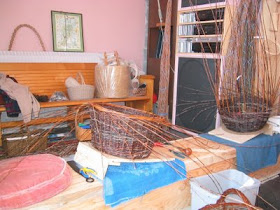Almost all my garden experience is from my past urban gardens where aphids and various kinds of viruses made up my "garden enemies", ruining some of the beauty during parts of the gardening season.
I never thought that a cute little cottontail would become my enemy #1, the one that frustrates me the most.

The little Fragrant Snowball Viburnum (Viburnum x carlcephalum) grew by 30-40 cm last summer, nearly doubling it's size and I was very happy as I love this shrub with its fairly long lasting, very fragrant white/pinkish balls in spring and its season long glossy, dark green leaves. This is what it looks like now: All growth from last year, every last shoot and bud that was ready for spring GONE.

The Pink Lady quinces (Chaenomeles x superba 'Pink Lady') were not only chopped down

but the bark at the base got a good chew too. Well, at least they left some "fertilizer" behind!
Unfortunately, even during the rest of the year when there's an abundance of food in the fields and natural areas around our property the rabbits still LOVE my garden. They don't understand that it's mine!! They love munching on the tender new shoots on garden plants in spring and the veggie garden all through the seasons if I don't fence it in.
Maybe I should get a hunting license!
 At this stage we had several extremely cold nights -20 to -30
At this stage we had several extremely cold nights -20 to -30  This was on January 29 and they are completely covered - just the outline of one
This was on January 29 and they are completely covered - just the outline of one  All those tips are dead, but everything below that snow is still green and alive. HAVE to condition myself to LOVE that snow!!!
All those tips are dead, but everything below that snow is still green and alive. HAVE to condition myself to LOVE that snow!!!



 I finished the basket and brought it home as "carry on" on the plane. The sun and the rusty colour in one of my sedums are really highlighting the basket here.
I finished the basket and brought it home as "carry on" on the plane. The sun and the rusty colour in one of my sedums are really highlighting the basket here. And here is my friend Frances, busy weaving. Visit her at
And here is my friend Frances, busy weaving. Visit her at  These baskets are made from "wild" willow collected in nature. The rods have been dried and then soaked before use to become flexible again so they can be woven without breaking.
These baskets are made from "wild" willow collected in nature. The rods have been dried and then soaked before use to become flexible again so they can be woven without breaking. And here it is, my second basket. And yes, it is obvious that it is the work of a beginner - but, hey I made it.
And here it is, my second basket. And yes, it is obvious that it is the work of a beginner - but, hey I made it.